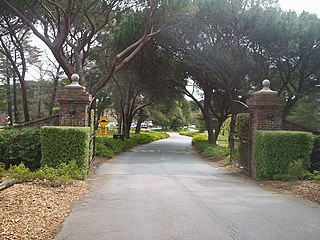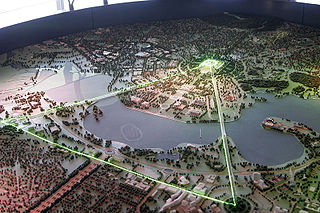



The Albert Hall is a hall in Canberra, Australia, used for entertainment. It is on Commonwealth Avenue between Commonwealth Bridge and the Hotel Canberra in the suburb of Yarralumla.




The Albert Hall is a hall in Canberra, Australia, used for entertainment. It is on Commonwealth Avenue between Commonwealth Bridge and the Hotel Canberra in the suburb of Yarralumla.
The hall was opened on 10 March 1928 by the Prime Minister, Stanley Bruce. Bruce named the hall, explaining at the opening ceremony that he had chosen the name from the Royal Albert Hall in London and also because it was the first name of The Duke of York (later George VI) and furthermore that it commemorated the "Consort of the Queen who had proclaimed the Australian Commonwealth".
The hall was originally designed by the Federal Capital Commission architect David Limburg, under Chief Architect Henry Rolland, then amended before construction. It is in the Federal Classical style. A porte-cochere at the front allows for passengers from vehicles to alight undercover.
The Hall comfortably seats around 400 people in open-spaced rows of seats.
Albert Hall’s east end has a Foyer with three sets of doors from the porte-cochere and a further three sets leading to the Hall. On the south side is the original ticket booth and toilets for men and women. On the northern side is a small entertaining room with kitchen and servery; the main Hall’s chairs are stacked here when not in use. The floor above has on the east side a small suite of offices for meetings, and on the side facing into the Hall is a mezzanine with raked fixed seating for about 50 people, accessed by stairs from the Foyer. Over the small entertaining room is a flat roofed outdoor area that may be used for entertaining by users of the offices.
Behind the stage on the west end are two suites of preparation rooms for performers, one on either side. There is no interconnection, or passage around the stage area.
The hall was not heated in its early years, and patrons had to bring rugs, thick coats and water bottles. Singers were known to perform in fur coats until heating was finally installed after World War II. [1]
On 27 January 1949, the Albert Hall hosted the inaugural meeting of the Canberra branch of the Liberal Party of Australia. [2]
Prior to its construction, the largest hall in the Federal Capital Territory was at the Causeway in Kingston. Until the completion of the Canberra Theatre in 1965, the Albert Hall was the only place in Canberra for audiences of more than 700 people other than the cinemas.
The Albert Hall remains the 'city hall' for Australia's national capital, used for civic, cultural and community functions and with some commercial use. It is heavily booked on weekends and during the week for private events, dances, balls, performances, cultural activities and commercial sales.
On 22 February 2007, the National Capital Authority (NCA) released National Capital Draft Amendment 53 - Albert Hall Precinct. This amendment to the development plans for the city was intended to reinstate some of the plans that were originally made by Walter Burley Griffin when he designed the city in 1912, which had been neglected in the years following Griffin's departure from Canberra, when the Albert Hall was constructed. The plan intended to reinforce the geometry, landscape and purpose of the area surrounding the Albert Hall, including Commonwealth Avenue in front of the hall, and the open space facing Lake Burley Griffin at its rear. In particular, the amendment suggested that the land around the Albert Hall would be opened up for commercial purposes such as cafes and tourist facilities. The amendment also made reference to a 'landmark building' north of Albert Hall, which would presumably house these facilities. [3]
There was a lot of discussion about the plans outlined in the amendment. An action group formed to oppose the plan, under the emotive catch-cry of "Save Albert Hall". Ongoing public debate and anger directed towards the authorities involved led to the National Capital Authority holding public meetings on 5 March, and later added more meetings on 22 and 24 March. Finally, at a meeting on 2 April 2007, it was agreed that the NCA would not proceed with the landmark building, and that the land would be used as a "public lakeside park". [4] The organisation continues to campaign to protect the Albert Hall and its precinct. The building, which was previously listed only on the Heritage Places register, has been suggested for inclusion on the National Heritage List, which would make it extremely difficult for government authorities to make further attempts to develop the precinct. In the lead-up to the 2007 Federal Election, the Labor Senator Kate Lundy committed $500,000 to the restoration of the Albert Hall.
A Compton Theatre Organ was installed in Albert Hall in the late 1980s, after the ACT Division of the Theatre Organ Society of Australia took delivery of its components and spent almost ten years restoring the organ. Its inaugural concert was on 17 August 1986, with organist Tony Fenelon. This organ had originally been, from March 1933 until 1968, in the Gaumont Palace (later renamed the Odeon Theatre) in Cheltenham, Gloucestershire, UK. [5]

The Australian Capital Territory (ACT), known as the Federal Capital Territory (FCT) until 1938, is a federal territory of Australia. Canberra, the capital city of Australia, is situated within the territory, and serves as the territory's primate city. It is located in southeastern Australian mainland as an enclave completely within the state of New South Wales. Founded after Federation as the seat of government for the new nation, the territory hosts the headquarters of all important institutions of the Australian Government.

Canberra is the capital city of Australia. Founded following the federation of the colonies of Australia as the seat of government for the new nation, it is Australia's largest inland city and the eighth-largest Australian city overall. The city is located at the northern end of the Australian Capital Territory at the northern tip of the Australian Alps, the country's highest mountain range. As of June 2023, Canberra's estimated population was 466,566.

Walter Burley Griffin was an American architect and landscape architect. He designed Canberra, Australia's capital city, the New South Wales towns of Griffith and Leeton, and the Sydney suburb of Castlecrag.

Government House, colloquially known as Yarralumla, is the official residence of the governor-general of Australia. It is located in the suburb of Yarralumla, in the City of Canberra, in the Australian Capital Territory. The house is set amid 54 hectares of parkland. The house and associated grounds were added to the Commonwealth Heritage List on 22 June 2004.
The history of Canberra details the development of the city of Canberra from the time before European settlement to the city's planning by the Chicago architect Walter Burley Griffin in collaboration with Marion Mahony Griffin, and its subsequent development to the present day.

Lake Burley Griffin is an artificial lake in the centre of Canberra, the capital of Australia. It was completed in 1963 after the Molonglo River, which ran between the city centre and Parliamentary Triangle, was dammed. It is named after Walter Burley Griffin, the American architect who won the competition to design the city of Canberra.

Yarralumla is a large inner south suburb of Canberra, the capital city of Australia. Located approximately 3.5 km (2.2 mi) south-west of the city, Yarralumla extends along the south-west bank of Lake Burley Griffin from Scrivener Dam to Commonwealth Avenue.

Barton is a suburb of Canberra, Australian Capital Territory, Australia. At the 2021 census, Barton had a population of 1,946 people.

Kingston is the oldest and one of the most densely populated suburbs of Canberra, Australian Capital Territory, Australia. The suburb is named after Charles Cameron Kingston, the former Premier of South Australia and minister in the first Australian Commonwealth Government. It is adjacent to the suburbs of Barton, Fyshwick, Griffith and Manuka. The suburb of Kingston is situated about 4 km from the centre of Canberra.

The Canberra Golf Club, later known as the Royal Canberra Golf Club, was formed in 1926. Its original grounds were behind the Hotel Canberra on the river flats on both sides of the Molonglo River.

The National Triangle, which is referred to as the Parliamentary Triangle, is the ceremonial precinct of Canberra, containing some of Australia's most significant buildings. The National Triangle is formed by Commonwealth, Kings and Constitution Avenues. Buildings within the National Triangle have been located and designed intentionally for visual effect, and those of national significance are popular tourist attractions.

Commonwealth Place is located on the southern shore of Lake Burley Griffin, Canberra. It lies along the ‘water axis’ running along the lake from Black Mountain. Commonwealth Place is the location of the Gallery of Australian Design, Reconciliation Place, a restaurant and Speakers Square. Walter Burley Griffin, the architect who designed Canberra, envisaged that the area would be the site of a "water gate" which would have a terrace above it, providing a "forum for the people". Griffin's vision was for a long time left unrecognised but as of 2005 the area was being developed to reflect the original plan.

Kings Park is a park in Canberra, Australia on the shore of Lake Burley Griffin.

Commonwealth Avenue is a major road in Canberra, Australian Capital Territory, Australia. It connects Civic with South Canberra. Specifically, it runs between City Hill and Capital Hill.
The history of the Australian Capital Territory (ACT) as a separate administrative division began in 1911, when it was transferred from New South Wales to the Australian federal government. The territory contains Australia's capital city Canberra and various smaller settlements. Until 1989, it also administered the Jervis Bay Territory, a small coastal region.

The history of Lake Burley Griffin, an artificial body of water in Canberra, the capital of Australia, is highly complex. Following its initial design in the 1910s, extensive political disputes occurred until it was finally built in the 1960s.
The National Capital Authority (NCA) is a statutory authority of the Australian Government that was established to manage the Commonwealth's interest in the planning and development of Canberra as the capital city of Australia.

Hotel Kurrajong Canberra is a heritage-listed hotel located in the Canberra suburb of Barton, Australian Capital Territory, close to Parliament House and national institutions within the Parliamentary Triangle precinct. The Hotel has a strong association with Australia's political history, most notably as the residence of Prime Minister Ben Chifley throughout his parliamentary career, including his term in office from 1945-1949. In 1951, Chifley suffered a fatal heart attack in room 205 at Hotel Kurrajong.

The Commonwealth Avenue Bridge are two parallel pre-stressed concrete box girder road bridges that carry Commonwealth Avenue across Lake Burley Griffin, and connect Parkes and City in Canberra, in the Australian Capital Territory, Australia.

The Embassy of Russia in Australia is the Russian embassy in Canberra, Australian Capital Territory. It is located at 78 Canberra Avenue, Griffith, to the east of the Manuka shopping precinct.